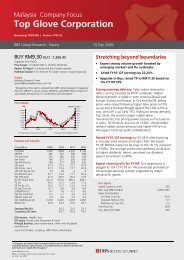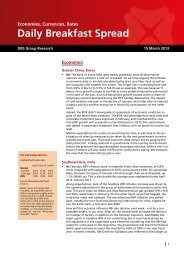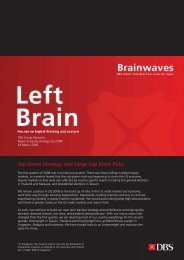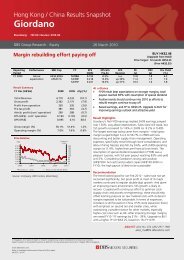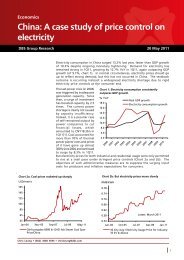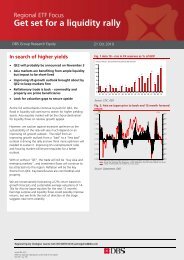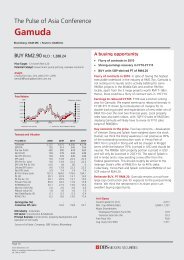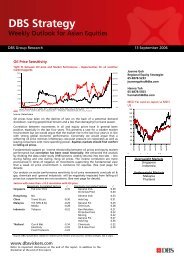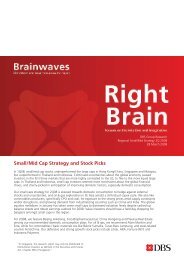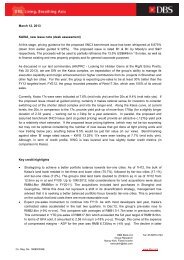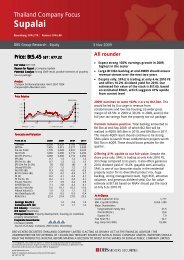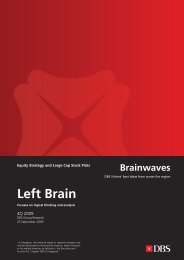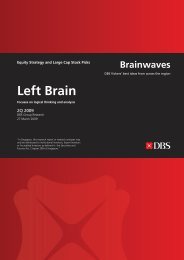Economics Markets Strategy - the DBS Vickers Securities Equities ...
Economics Markets Strategy - the DBS Vickers Securities Equities ...
Economics Markets Strategy - the DBS Vickers Securities Equities ...
Create successful ePaper yourself
Turn your PDF publications into a flip-book with our unique Google optimized e-Paper software.
<strong>Economics</strong>: Philippines<br />
<strong>Economics</strong> – <strong>Markets</strong> – <strong>Strategy</strong><br />
With its inflation<br />
target shattered,<br />
<strong>the</strong> central bank<br />
will lift interest<br />
rates by a fur<strong>the</strong>r<br />
75bps, taking <strong>the</strong><br />
repo rate to 7.25%<br />
by end-08<br />
Slower growth in<br />
<strong>the</strong> US will weigh<br />
on remittances;<br />
peso weakness<br />
helps only to a<br />
degree<br />
Business spending<br />
will rise by a decent<br />
7% this year, but<br />
largely on public<br />
spending<br />
As will interest rate hikes<br />
Still, our inflation forecasts are well above <strong>the</strong> BSP’s inflation targets for this<br />
year and <strong>the</strong> next. This year <strong>the</strong> central bank’s inflation target is at 3-5%, and<br />
next year inflation is targeted at 2.5-4.5%. In view of this, we expect <strong>the</strong> central<br />
bank to continue <strong>the</strong> tightening cycle it embarked on earlier this month. The<br />
overnight reverse repo (borrowing) and repo (lending) rates were lifted 25bps<br />
to 5.25% and 7.25% respectively, and we expect a fur<strong>the</strong>r 75bps of tightening<br />
before <strong>the</strong> year is up, to be delivered in three moderate steps of 25bp each.<br />
These interest rate hikes should help to contain risks of a wage-price spiral by<br />
dampening activity. Under pressure from <strong>the</strong> unions to mitigate <strong>the</strong> impact of<br />
higher food and fuel prices on workers, <strong>the</strong> government in mid-May mandated<br />
a nation-wide increase in private-sector minimum wages, to be rolled out in <strong>the</strong><br />
different regions over <strong>the</strong> next few months. Some areas (like metro Manila) will<br />
see moderate hikes of around 5%, but increments in some provinces will come<br />
to around 10%. Some of <strong>the</strong>se wage increments will also come on top of previous<br />
wage orders still currently being implemented. As part of a longer-standing<br />
plan, public sector workers are also set to receive a 10% pay rise on July 1.<br />
Admittedly, even after lifting rates by a fur<strong>the</strong>r 75bps, monetary policy can still<br />
be described as “loose”; after adjusting interest rates for inflation, <strong>the</strong>y are<br />
negative. In o<strong>the</strong>r words, <strong>the</strong> value of money sitting in a consumer’s bank deposit<br />
actually decays, and <strong>the</strong>re is greater incentive for him to take it out to spend or<br />
invest. But free spending would occur only if consumers had no concerns over<br />
economic and labour market prospects.<br />
Clearly this will not be <strong>the</strong> Chart 5: Remittances and real US GDP growth<br />
case in <strong>the</strong> coming quarters.<br />
We continue to expect <strong>the</strong> US<br />
% YoY % YoY, 3mma<br />
to fall short of longer-term 4.5<br />
30<br />
potential growth both this year<br />
Remittances<br />
4.0<br />
and <strong>the</strong> next, having pencilled<br />
(RHS)<br />
US GDP<br />
25<br />
3.5<br />
in growth of 2.0% and 2.6%<br />
respectively; potential growth 3.0<br />
20<br />
is widely thought to be between 2.5<br />
2.75-3.25%. Given that <strong>the</strong> US<br />
15<br />
2.0<br />
accounts for 53% of <strong>the</strong><br />
Philippines’ remitted earnings 1.5<br />
10<br />
and 17% of <strong>the</strong> export market, 1.0<br />
this will have a negative bearing<br />
5<br />
on domestic wage and spending<br />
0.5<br />
patterns (Chart 5). Fur<strong>the</strong>r 0.0<br />
0<br />
weakness in <strong>the</strong> peso this year Mar-02 Mar-04 Mar-06 Mar-08<br />
will help soften <strong>the</strong> blow on<br />
both remitted earnings and<br />
exports – we expect USD/PHP to end <strong>the</strong> year at 47.00 – but not sufficiently.<br />
Investment to remain robust on public spending<br />
Investment spending was <strong>the</strong> only component in <strong>the</strong> first quarter GDP figures<br />
that did not disappoint us, and while we believe last year’s 11.8% surge in<br />
capital outlays will not be replicated, investment this year should still rise a<br />
decent 7.0%. However, this is likely to ride on public, ra<strong>the</strong>r than private outlays.<br />
As input costs like oil and commodities continue to rise and it becomes increasingly<br />
difficult to pass on higher costs to consumers, private firms will feel greater<br />
margin pressure. In such an environment, business spending plans will naturally<br />
be deferred. Indeed, private-sector investment indicators so far this year have<br />
been very weak. According to <strong>the</strong> BSP’s second-quarter Business Expectations<br />
128



